The grounds of the Kentucky Horse Park are home to many museums tracking the history and accomplishments of horses. Whether they are tailored to a specific breed or offer a look at a general history between humans and horses, the museums are suited for everyone, regardless of their knowledge of horses.
USEF Lobby Museum
For those uninitiated with equestrian breeds and disciplines, the lobby of the U.S. Equestrian Federation headquarters contains displays aimed at educating new visitors.
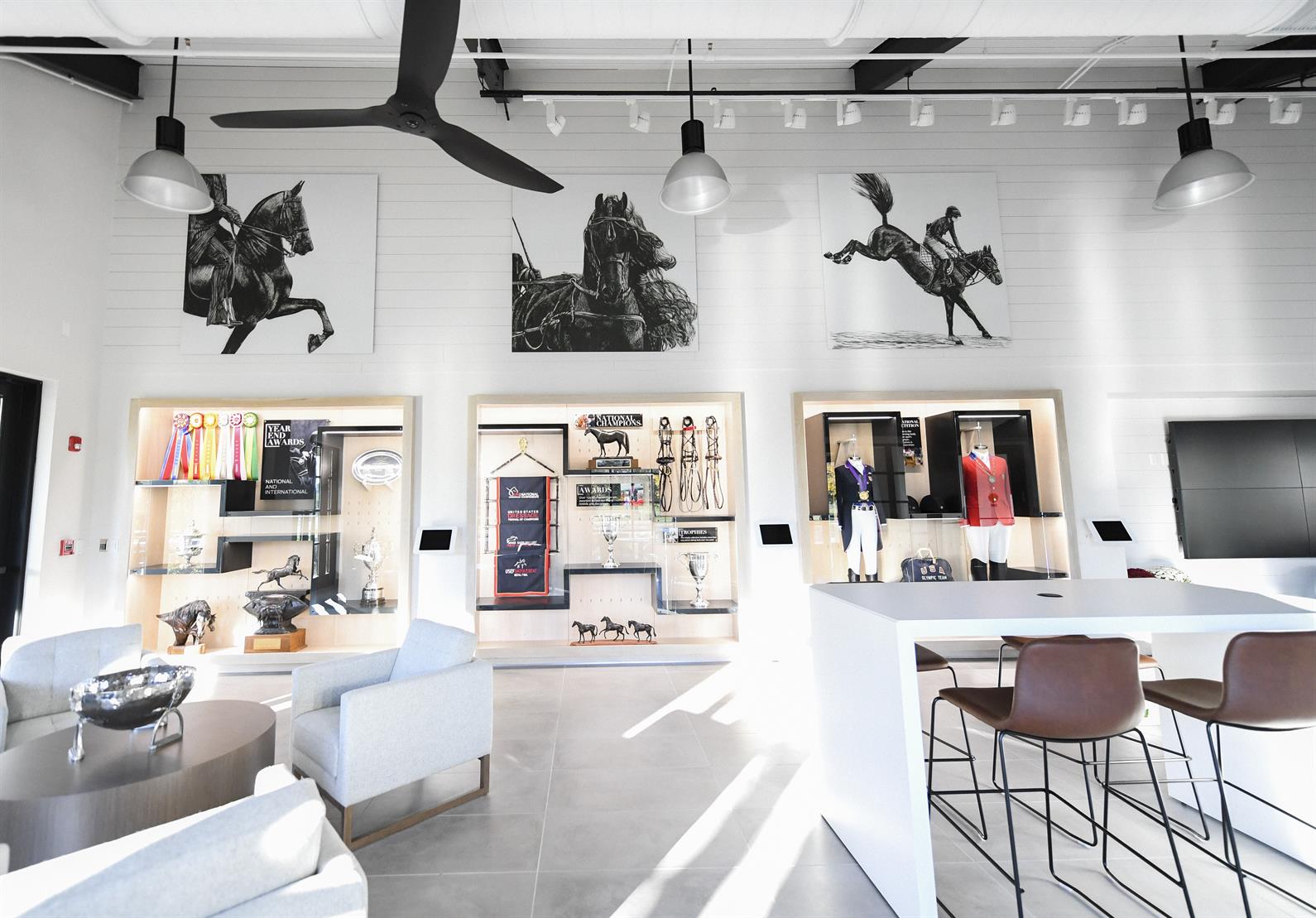
In addition to expansive linocut pieces by artist Sarah Lockwood-Taylor, the lobby contains three main displays highlighting international sport, national breeds and disciplines, and USEF’s most celebrated annual awards. Within the displays are trophies and memorabilia from competitions and awards, including the USEF Horse of the Year and Lifetime Achievement trophies.
“These great historic trophies have been a part of the USEF for many, many years, and we wanted to be able to showcase them and educate people that came into the lobby,” said USEF Chief Marketing and Content Officer Vicki Lowell.
The lobby also showcases apparel and equipment typically used in equestrian competition; for example, female and male mannequins display U.S. Team dressage and jumping attire. Helmets and boots from USEF sponsors (Charles Owen and Ariat, respectively) are also on display.
“The goal was to have some things that were very physical and tactile and representative of what would be utilized in the sport,” Lowell said.
Also featured are items from renowned equestrians, such as a trunk and Olympic team bag owned by Olympic show jumper and gold medalist William Steinkraus from the 1972 Munich Olympic Games.

“I'm trying to get [Olympic eventer] David O'Connor, USEF Chief of Sport, to bring his gold medal in and put it on display, and he may also bring his saddle from the Olympics,” Lowell said. “We think those would be two really nice additions to feature.”
While other equipment is donated by local partners or sponsors, the trophies in the lobby come from USEF’s collection of approximately 180 active trophies.
“They used to all just live in storage,” Lowell explained. “The idea was to really showcase these incredible trophies and to be able to share who has won them in the past.”
In addition to sourcing new items, USEF is also working on developing interactive content on mounted iPads to complement each display. The interactive content is projected to be operational this fall.
“[You can] tap a discipline or breed to learn more, and it comes up and gives you the history about them and what they look like, how they move, because a lot of our specific breeds that we have move very differently,” explained USEF marketing specialist Jera Jordan. “And then with the trophy area, we're planning on having it where you can tap on each trophy, and it’ll come up and you can look at it and read about why it was donated. I’m pretty excited to see that launch.”
USEF’s hours of operation are 8:30 a.m. to 5 p.m. Monday through Friday. For more information, visit usef.org.
American Saddlebred Museum
Now located next to the Horse Park’s visitor center, the American Saddlebred Museum started in 1962 at nearby Spindletop Hall on Iron Works Pike.
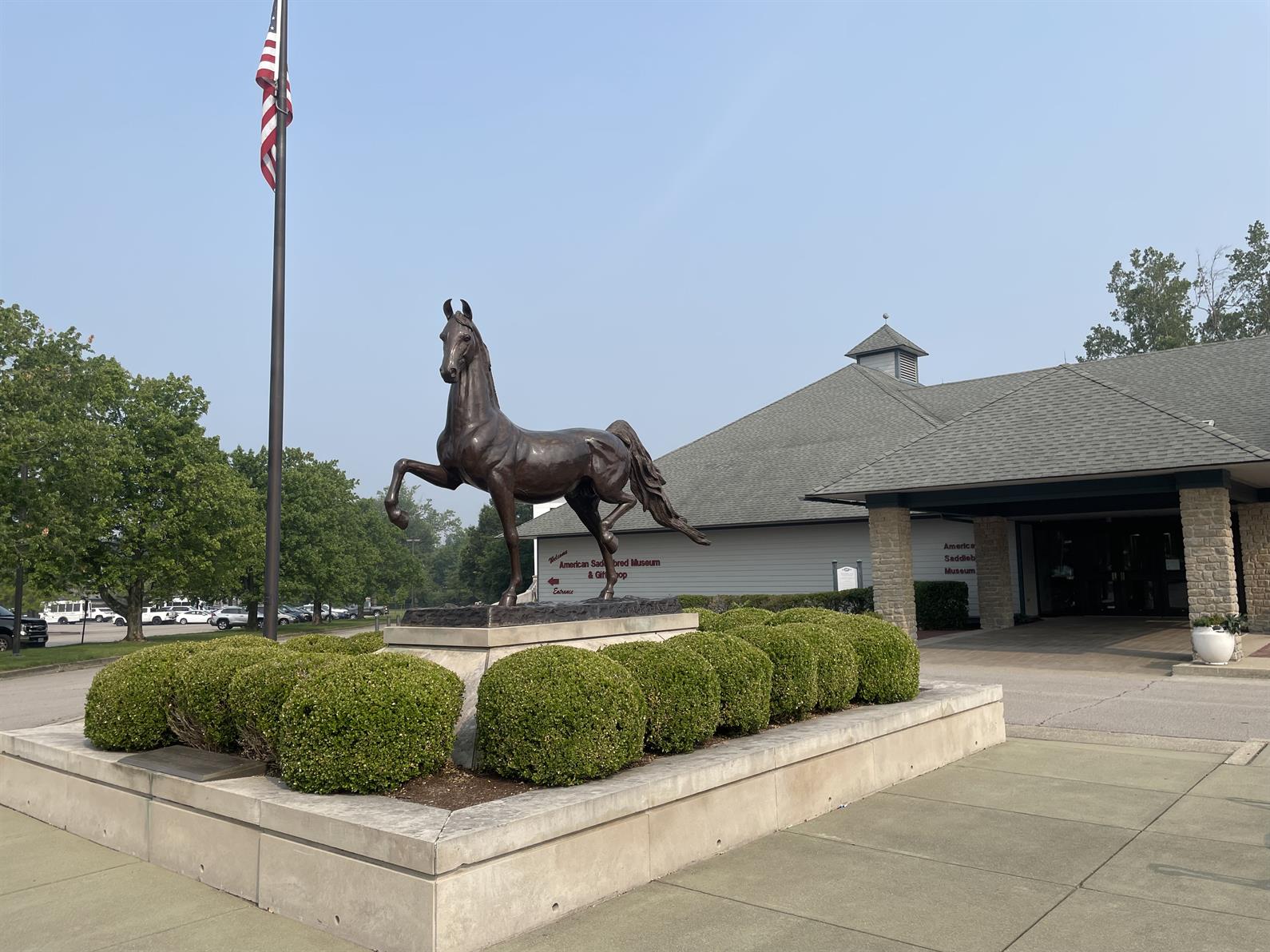
“Saddlebred enthusiasts wanted a place to make sure their history was kept alive,” said Amy Nelson, the museum’s Marketing, Development, and Collections Manager.
Upon entering through the gift shop, visitors are met with the George Ford Morris Gallery, housing one of the most extensive collections of the 20th century equine artist’s Saddlebred artwork. The entrance also contains a spotlight exhibit focusing on an influential horse or trainer, as well as a flexible gallery space often used for events.
The museum’s largest area, however, is its Elisabeth M. Goth History Wing. The wing contains displays explaining the origin of the breed, its contributions to American history, and its versatile skills that continue in the present day.
“We want [visitors] to learn about our breed and to realize how unique and special it is and that it is a true Kentucky horse. It's evolved from being a horse on the farm, a horse in wartime, to the family Sunday afternoon horse, to what it is today,” Jennifer Foster, the museum’s Executive Director, said. “We try to show that the Saddlebreds are very versatile. They don't just do shows. There are Saddlebreds in the Rose Parade, they compete in jumping and dressage shows, and they are in movies. Also, they can be mild-mannered for therapy riding.”
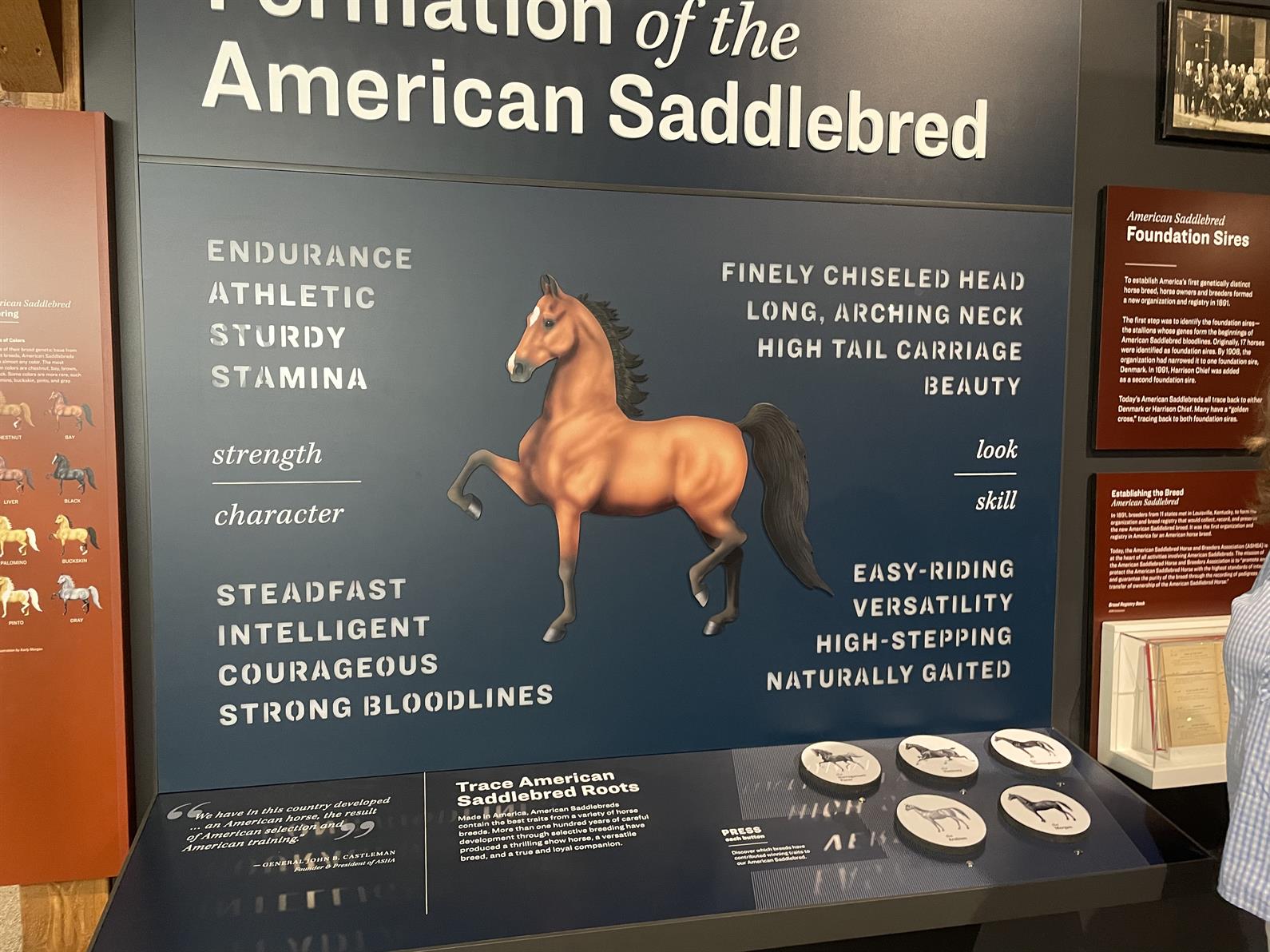
The history wing also contains interactive exhibits that allow guests to braid horse tails, handle barn equipment, and get an overall impression of the responsibilities that go along with owning a horse. Additional information is displayed regarding important trainers, influential horse owners, and the different competitive divisions where you can find American Saddlebreds.
When asked what makes American Saddlebreds unique, Foster explained that, much like other breeds, the Saddlebred has a specific personality.
“They're very intelligent, beautiful animals,” Foster said. “Their nickname is ‘the peacock of the show ring,’ but I think they're just a special horse with lots of personality. I know when mine's happy and when she isn't.”
“People have a special connection with the breed,” Nelson added. “I think that's really important—the horse and human relationship.”
The museum’s next exhibition, scheduled to open this fall, is “All the Pretty Horses: American Saddlebred Fine Art.” It will showcase sculptures, paintings, and drawings featuring the breed. The museum’s seasonal hours are Wednesday through Sunday from 9 a.m. to 5 p.m. For more information, visit asbmuseum.org.
International Museum of the Horse
Also open seasonally, the International Museum of the Horse tracks the history of humans domesticating and working with horses around the world. Encompassing 64,000 square feet, the museum is the largest museum in the world focused on the history of horse-human relationships.
“The museum itself takes you around the whole story of the horse around the world,” explained Curator of exhibits Noa Leibson. “There’s really something for everyone here because it's such a diverse collection.”
The museum also showcases chariots, carriages, memorabilia from famous racehorses such as Man o’ War and Seattle Slew, a gallery of rotating art exhibitions, a painting by famous horse portrait artist Edward Troye, and numerous Triple Crown trophies from the famous Calumet Farm, a thoroughbred breeding operation.
One of the museum’s newest exhibits is the “Black Horsemen of the Kentucky Turf” exhibit, chronicling the history and contributions of Black Americans to the horse industry.
“In a lot of places, it’s a very white, male, straight-centric history that people learn, and people just don't know the history of African Americans who were involved in the horse industry. They truly were pillars,” Leibson said. “It's just very moving, knowing that for a long time, history shoved them under the radar or mistreated these people, and now their grandchildren and great-grandchildren can see their legacy come alive again.”
Another new addition is the Al-Marah Arabian Horse Gallery. Funded by the Purebred Arabian Trust, the gallery showcases the history of the Arabian horse and its journey from the Middle East to Europe and the United States. The gallery features many interactive exhibits and around 200 Arabian horse artifacts.
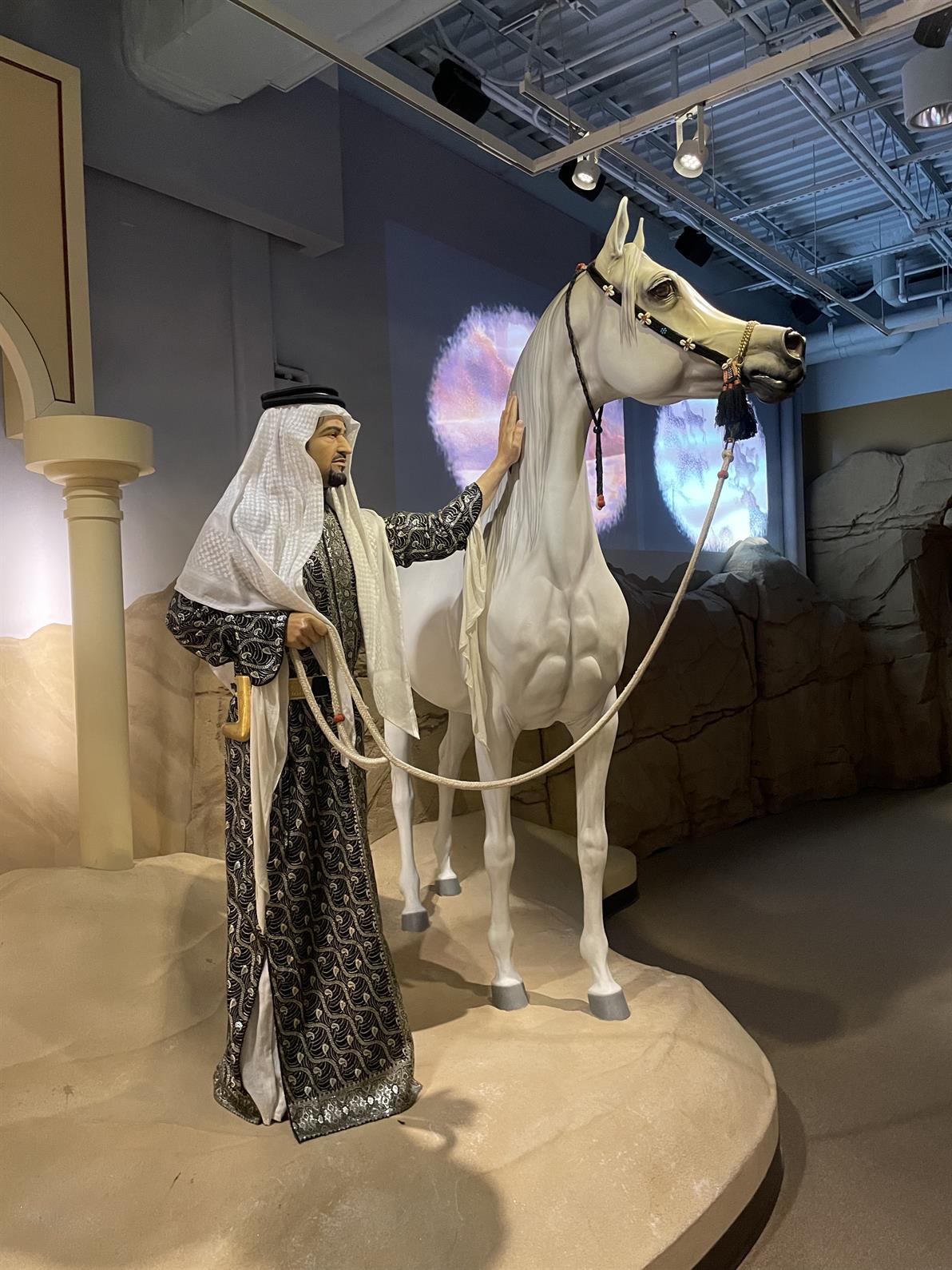
“It's cool because people can come to these exhibits and see what we have come to life throughout the park,” Leibson said. “We do get people who have never seen a horse before, and for some of them, this is their first stop because it's right next to the visitor center. They get this overview, and then they say, ‘Oh, okay, I'm going to get hands-on now. I gotta go see it.’”
An example of this is the Hall of Champions, where visitors can interact with accomplished horses whose awards and memorabilia are displayed in the museum.
“[Park staff and volunteers] run the shows here. They'll see people around and bring out the horses, play their videos, teach people about them,” Leibson said. “If you come to the shows, you'll get different horses for every purpose.”
The Hall of Champions also serves as a memorial garden, with many winning horses through the decades buried there. However, the Hall of Champions is not the only place where famous horses are memorialized; the museum also contains the bones of multiple horses, including the skeleton of the acclaimed Thoroughbred stallion Lexington, who recently became the subject of a novel by Geraldine Brooks.
“If you know the book ‘Horse’—it's very popular now—but we've had people coming from all over America to visit him because of this book,” Leibson said.
The International Museum of the Horse is currently planning two future exhibits. One, coming in September, is a lobby case focusing on Jena Antonucci, the first woman to train a winner of a Triple Crown race. Another, scheduled to open in March, is centered around horses in Japan.
The museum is currently open Wednesday through Sunday from 10 a.m. to 4 p.m. For more information, visit ihm.org.
USHJA Wheeler Museum
The Wheeler Museum, named after hunter/jumper trainers Kenny and Sallie Wheeler, is located within the United States Hunter Jumper Association headquarters. It opened in 2009 and aims to preserve and share the legacy of the hunter/jumper sport. Supported by donors and fundraising efforts from the USHJA, the museum features both a permanent collection of donated artifacts and a series of rotating exhibits. The most recent exhibit, “From the Hunt Field to the International Hunter Derby: American Show Hunters,” launched in April 2023.
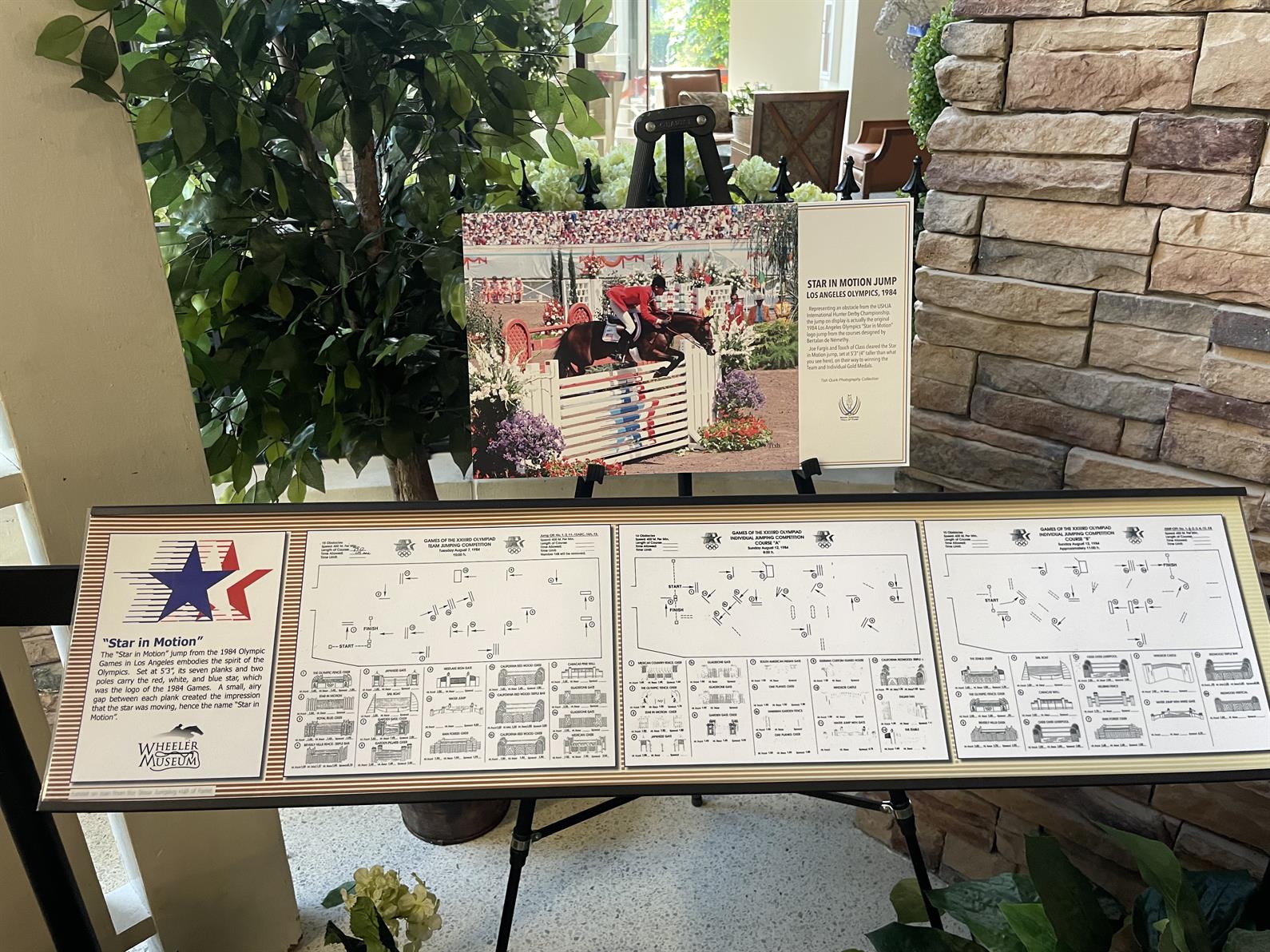
“This exhibit rounds out the various themes of the past exhibits. We’ve focused on thoroughbred show horses, equitation, and jumpers, so our curator thought it was time to highlight hunters,” said Whitney Barnard, the USHJA’s Assistant Managing Director of Education. “It takes you through the discipline’s origins in fox hunting, and then it wraps through early show traditions and brings you to where we are.”
“We also make sure there are always some Show Jumping Hall of Fame items on display. We've got Olympic medals and memorabilia from the United States Equestrian Team from back in the day, so we like to keep some of those things on display in addition to the thematic topical exhibit that's up,” explained curator Denise Quirk, who has designed three of the exhibits. “We aim to reach a broad range of audiences. There’s something there for the very horse-savvy, as well as for someone who's in the park because horses are interesting to them, but they don't know much about the hunter/jumper sport.”
The Show Jumping Hall of Fame permanently resides in the Wheeler Museum, which also features interactive displays that show past exhibits, preserved Olympic jumps, and medals and memorabilia from international competitions.
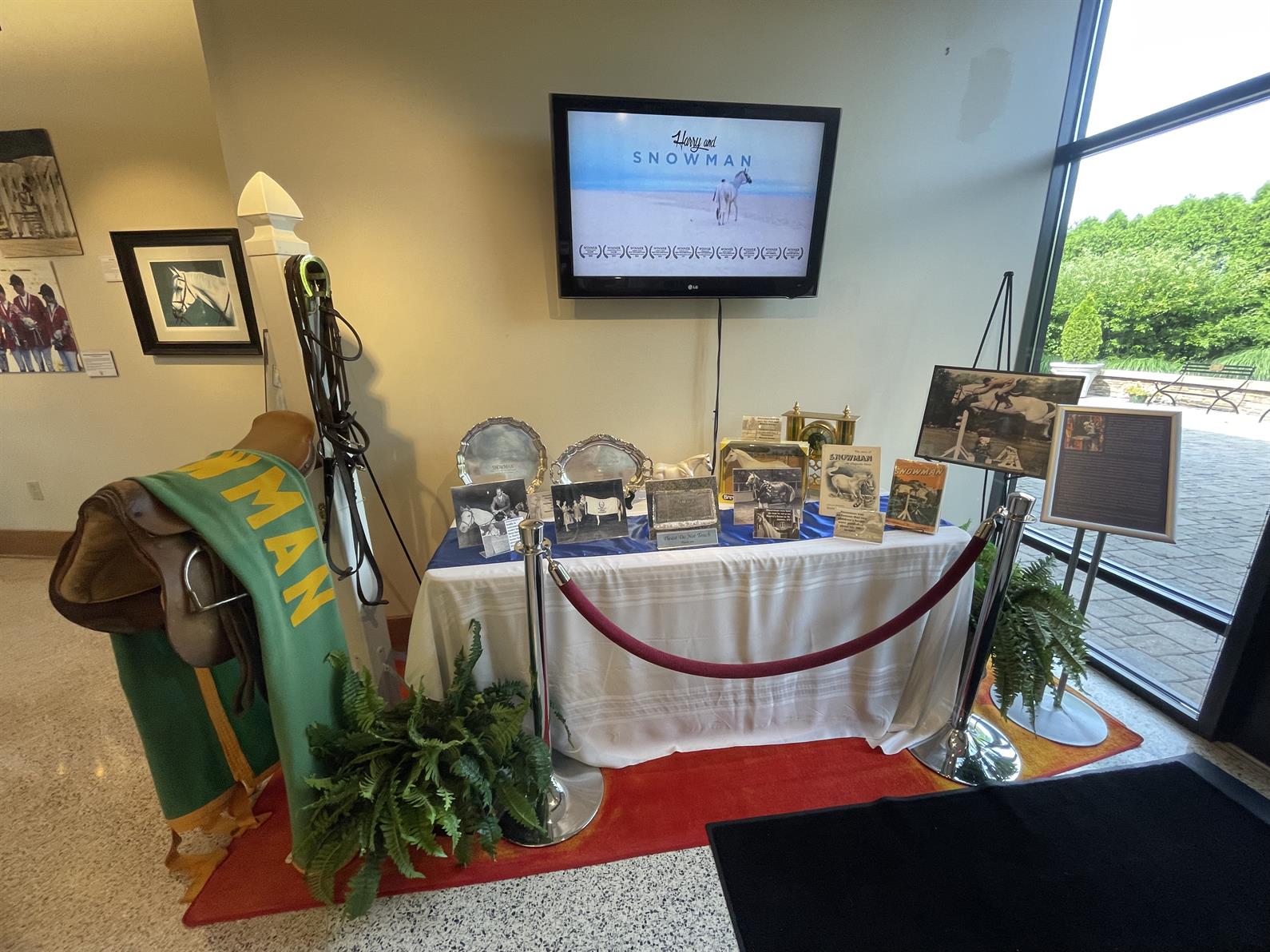
“Most people don't know what an Olympic medal looks like, so we think it’s pretty cool,” Barnard said.
Quirk explained that the physical artifacts, such as photography collections, statues, and formal hunter attire, are her favorite parts of the museum.
“Pictures are great, and we have our exhibits online, but I think when people can actually see things in the flesh and get a 360-degree view of it, that makes it a little more real to people,” she said.
“Yesterday, a family walked in, so it's always kind of fun,” Barnard added. “Even if they don't have time to sit down and read all of the texts, it’s visually appealing.”
The USHJA headquarters public hours are 8:30 a.m. to 5:00 p.m., Monday through Friday. In addition to the museum, the building houses a collection of historical and perpetual trophies related to hunter/jumper disciplines. For more information, visit ushja.org/education/sport-historymuseum.
Paso Fino Horse Association
Not all museums dedicated to USEF-recognized breeds and disciplines are located at the Kentucky Horse Park. Previously headquartered in Florida and at the Kentucky Horse Park, the Paso Fino Horse Association is currently moving to a new building in Frankfort.
“We're hoping to create a little museum and a new office space, because we'll have more space than what we currently have at the Horse Park,” said PFHA Registrar and Executive Director Amy Collingsworth. “A lot of new members today are the younger group who don't quite grasp some of the history, so we would like to have a place that they can go back and look at all that information.”
In addition to a Hall of Fame, the new location will display historical photographs, books, and posters donated by longtime PFHA members, part of an effort to display accumulated history in one central location.
"A lot of the photos, posters, and historical magazines that are bound are down there in Florida right now. We had them displayed during our [Grand National Championship] show,” Collingsworth explained. “We’re hoping to move stuff that's from Florida back up here to Kentucky, and then hopefully gain some more historical items from some of the other older members.”
“A lot of us that were there in the beginning still have tons of stuff in our garages and different storage units,” added lifetime PFHA member Robin Ratliff.
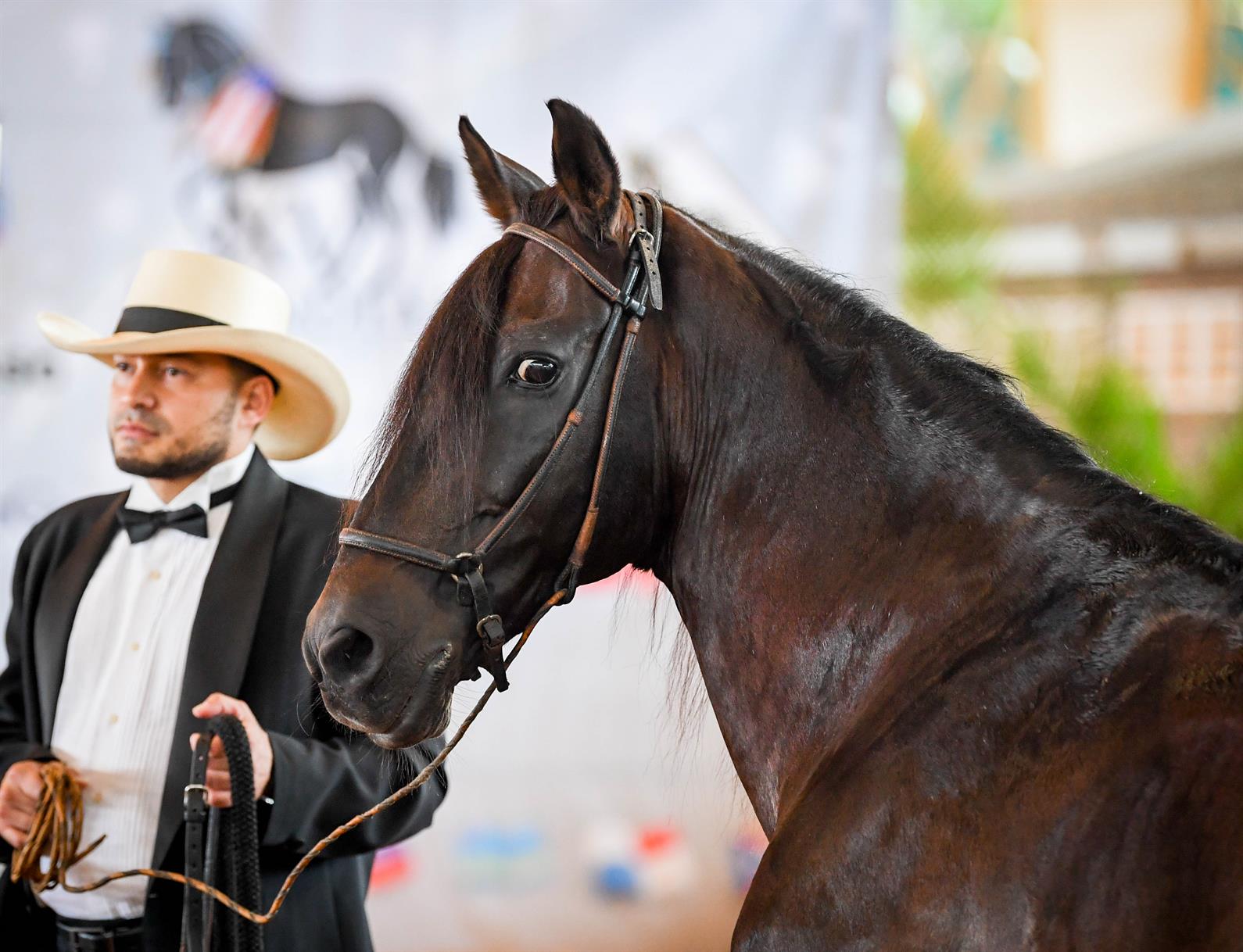
The move to the new location began on August 1, and the PFHA aims to have the historical items transported and set up by January 2024—in time for the association to host its Board of Directors meetings in Frankfort.
With its new location, the PFHA hopes to increase community outreach and interest in the breed. Ratliff specifically mentioned a desire to highlight the potential of the Paso Fino, specifically its famously smooth gait and smaller size. More information about the PFHA can be found at pfha.org.
“We still have a good amount of work to do to bring the Paso Fino up to the level of some of these other breeds that have prominence,” Ratliff said. “My hope is that as we go forward, [we’re] reminding people that we have the smoothest riding horse in the world. The younger generation [and] older people can ride into a very late age on this breed and feel very safe.”
Overall, these museums are not isolated entities: they all aim to contribute to greater knowledge and education about and within the equestrian community.
“It just goes to show how connected Lexington is. Everyone knows each other,” Leibson said. “It's like a cell. The whole park all just bounces off each other.”


